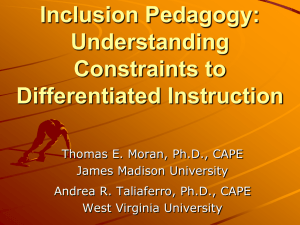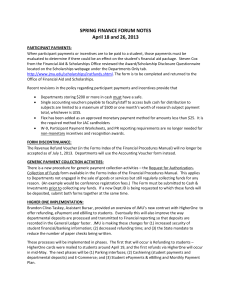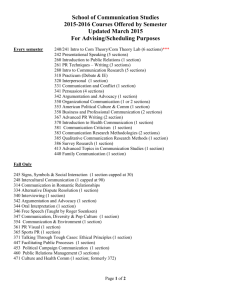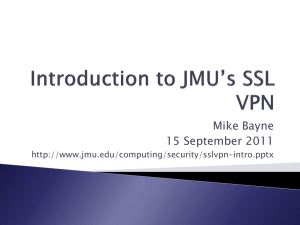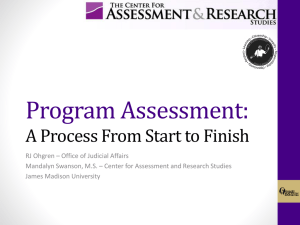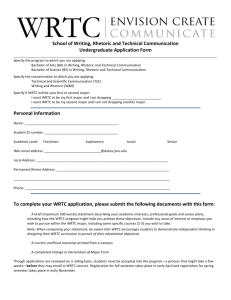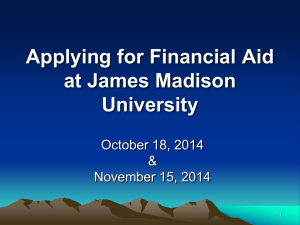Pre-Law at JMU
advertisement
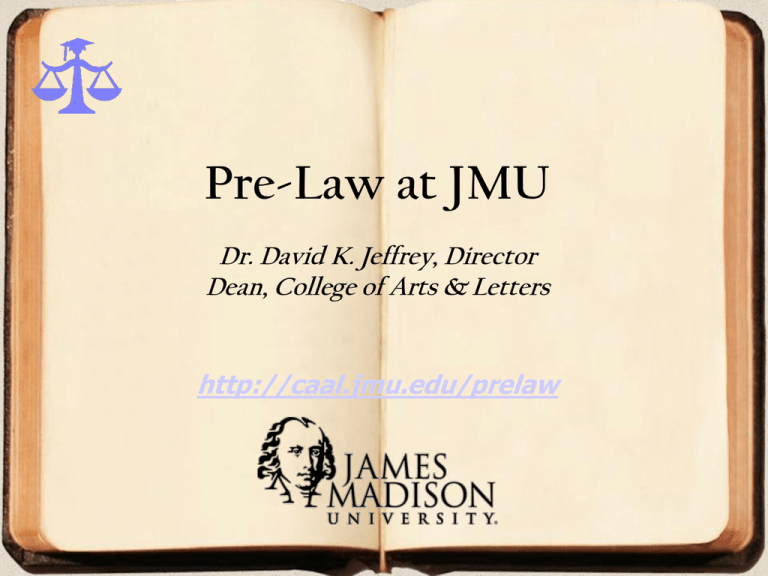
Pre-Law at JMU Dr. David K. Jeffrey, Director Dean, College of Arts & Letters http://caal.jmu.edu/prelaw The ABC’s And then some A. Four undergrad years leading to a degree. B. Three years of law school leading to a J.D. C. ANY undergrad major. D. Popular majors include: business, English, history, political science, psychology E. BUT … a recent W&L first-year class included majors in Latin, music, chemistry, education, philosophy, art, e.g. Undergrad Majors Specific majors with at least 1,000 applicants Selected other majors 2001 Applicants to ABA Approved Law Schools Major Applicants % of Total % Admitted Political Science 12,513 16.2% 71.1% History 5,154 6.7% 76.0% English 5,109 6.6% 75.3% Psychology 4,329 5.6% 72.1% Criminal Justice 3,227 4.2% 51.7% Economics 2,450 3.2% 77.9% Sociology 2,126 2.8% 63.6% Communications 2,028 2.8% 68.0% Business Administration 1,920 2.5% 60.3% Finance 1,914 2.5% 71.8% Accounting 1,765 2.3% 67.8% Philosophy 1,520 2.0% 80.4% Biology, General 1,486 1.9% 76.8% Business Management 1,317 1.7% 58.0% International Relations 1,239 1.7% 72.7% Biology, Specialization 548 0.7% 79.7% Chemistry, General 460 0.6% 78.8% Environmental Science 436 0.6% 76.6% Mathematics 303 0.4% 76.2% Computer Science 204 0.3% 72.1% Physics 138 0.2% 84.8% Core Skills And Values That Provide A Solid Foundation For Legal Education* 1. 2. 3. 4. 5. 6. 7. 8. Analytic And Problem-Solving Skills Critical Reading Abilities Writing Skills Oral Communication And Listening Skills General Research Skills Task Organization And Management Skills Values Of Serving Others And Promoting Justice General Knowledge a. Broad Understanding of History b. Fundamental Understanding of Political Thought c. Basic Mathematical and Financial Skills d. Understanding of Diverse Cultures *Report of the American Bar Association Task Force On Law Schools And The Profession JMU Courses To Consider General Education Courses • GBUS 160. Business Decision Making In A Modern Society • GCOM 121. Fundamental Human Communication: Presentations • GCOM 122. Fundamental Human Communication: Individual Presentations • GCOM 123. Fundamental Human Communication. Group Presentations • GHIST 150. Critical Issues In Recent Global History • GHUM 102. God, Meaning And Morality • GJUST 225. Justice And American Society • GPHIL 120 Critical Thinking • GPOSC 223. U.S. Government • MATH 103. The Nature of Mathematics Courses for Majors and Minors Business Law: BLAW 314. Real Estate Law BLAW 470. Financial Products: Regulation And Protection BLAW 495. Contract Law, Sales And Secure Transactions BLAW 497. Aspects Of International Business College Of Business COB 218. Legal Environment Of Business Communication Studies SCOM 231. Introduction To Alternative Dispute Resolution SCOM 240. The Process Of Human Communication SCOM 242. Presentational Speaking SCOM 331. Communication And Conflict SCOM 332. Mediation SCOM 431. Legal Communication Economics ECON 222. Contemporary Economic Issues And Policy Alternatives English ENGL 299. Writing About Literature ENGL 396. Advanced Composition Courses for Majors and Minors Justice Studies JUST 200. Introduction To Justice Studies JUST 210. Crime And Criminal Justice JUST 212. Theories Of Crime And Criminal Justice JUST 221. Social Justice Theories JUST 332. Understanding Violence JUST 323. Comparative Criminal Justice JUST 324. Death Penalty JUST 326. Victimology JUST 327. Criminal Law JUST 372. Ethics And International Politics Philosophy PHIL 250. Introduction To Symbolic Logic PHIL 270. Introduction To Ethics PHIL 310. Symbolic Logic PHIL 315. Logic And Legal Reasoning PHIL 325. Crime, Punishment And Justice PHIL 335. The Individual, The State, And Justice PHIL 367. Topics In The Philosophy Of Law Courses for Majors and Minors Information Analysis IA 200. Introduction Of National Security Inteligence IA 210. Introduction To Global Competitive Intelligence Political Science POSC 230. International Relations POSC 302. State And Local Government POSC 325. Constitutional Law POSC 326. Civil Rights POSC 386. The U.S. Judiciary POSC 395. International Law Psychology PSYC 250. Introduction To Abnormal Psychology PSYC 255. Abnormal Psychology For Law Enforcement Personnel PSYC 312. Forensic Psychology PSYC 314. Police Psychology PSYC 316. Human Development And Crime Courses for Majors and Minors Public Policy And Administration PPA 200. Introduction To Public Policy PPA 415. Legal Environment Of Public Administration Social Work SOWK 330. Corrections Sociology SOCI 325. Criminology SOCI 327. Juvenile Delinquency Spanish SPAN 360. Law Enforcement Spanish SPAN 370. Legal Spanish Writing, Rhetoric And Technical Communication WRTC 250. Ethical And Legal Issues In Technical And Scientific Communication WRTC 311. Rhetorical Analysis WRTC 320. Writing In The Public Sphere WRTC 411. Legal Writing PRE-LAW SOCIETY PHI ALPHA DELTA Deans of Admissions Financial Officers Lawyers KAPLAN LSAT Practice Tests Average LSAT Scores and GPA’s Of JMU Students and Alumni Accepted at Selected Law Schools, Fall of 2008 Schools American University Appalachian School of Law Catholic University Florida Coastal University George Mason University Hofstra University Penn State - Dickinson Temple University University of Alabama University of Arizona University of Pittsburgh University of Richmond University of Virginia Wake Forest Washington and Lee West Virginia University William and Mary LSAT 160 150 156 150 164 159 156 164 161 160 160 159 167 161 163 157 165 GPA 3.51 3.19 3.31 3.30 3.60 3.30 3.46 3.51 3.40 3.30 3.59 3.49 3.87 3.45 3.52 3.39 3.52 For helpful links and information about law schools and the process of applying to them, go to the Pre-Law Website: http://caal.jmu.edu/ PreLaw Law Schools That Admitted The Most JMU Students 2008-09 Academic Year American University 4 students Thomas Jefferson School of Law 5 students Appalachian School of Law 6 students University of Baltimore 8 students Catholic University 8 students University of Miami 4 students Charleston College 7 students University of Richmond 8 students Florida Coastal School 14 students University of Virginia 4 students George Mason University 4 students Washington and Lee 4 students Hofstra University 4 students West Virginia University 4 students New England School 7 students Widener University 8 students New York Law School 7 students William and Mary Law School 4 students Penn State - Dickinson 4 students Other Schools Two or three JMU students were admitted to these schools: Albany Arizona State Brooklyn California Western Campbell Cleveland State Cornell Duke Emory Florida State Fordham Georgia State John Marshall Michigan State—Detroit North Carolina Central Northeastern Notre Dame Pace Quinnipiac Rutgers-Camden Rutgers-Newark Suffolk Syracuse Thomas M. Cooley University of Alabama University of Arizona University of Arkansas University of Dayton University of District of Columbia University of Florida University of Iowa University of Maine University of Nebraska University of North Carolina University of Oregon University of South Carolina University of Tulsa Valparaiso Vanderbilt Villanova Wake Forest Acceptance Rate • • • Last year, 165 JMU students or alums applied to law school. 118 were accepted to one or more law schools. Our acceptance rate is 72%. Getting into Law School • • 80% of getting into law school depends on two numbers, your LSAT score and your GPA. 20% has to do with your recommendations, personal statement, extra-curricular activities, internships or summer employment in law firms or law-related businesses. GPA (Grade Point Average) 3.0 is a B average The LSAT • Three and one-half hour test • Given in February, June, October, December. • Four Parts •2 Logical Reasoning •1 Reading Comprehension •1 Analytical Reasoning • Scores •120-180 • Breakdown of most recent scores: •150,633 students took the test. •.06% scored 175-180 (i.e., 904 students) •2.4% scored 170-174 (i.e., 3,612 students) •19.5% scored 160-180 (i.e., 30,120 students) •Mean Score: 152.6 •Average UGPA: 3.26 Sample Question The crux of creativity resides in the ability to manufacture variations on a theme. If we look at the history of science, for instance, we see that every idea is built upon a thousand related ideas. Careful analysis leads us to understand that what we choose to call a new theme or a new discovery is itself always and without exception some sort of variation, on a deep level, of previous themes. If all of the statements in the passage are true, each of the following must also be true EXCEPT: (A) A lack of ability to manufacture a variation on a previous theme connotes a lack of creativity. (B) No scientific idea is entirely independent of all other ideas. (C) Careful analysis of a specific variation can reveal previous themes of which it is a variation. (D) All great scientific discoverers have been able to manufacture a variation on a theme. (E) Some new scientific discoveries do not represent, on a deep level, a variation on previous themes. Law School Curriculum First Year Law Courses, All Normally Required • • • • • • • Civil Procedure Contracts Torts Property Criminal Law Constitutional Law Legal Research and Writing Second and Third Year Courses • • • • Primarily Electives Moot Court Mock Trial Law Review Law School Specialties • Corporate Law • Antitrust Law • Intellectual Property Law • Family Law • Tax Law • Labor Law • Criminal Law • Public Interest Law • International Law • Securities Law • Environmental Law • Real Estate Law • Tort Law • Sports Law • Entertainment Law • Health Services Law What Do Lawyers Do? or, Where Will I Work? The Large Law Firm • 200 + including Partners and Associates Small Firms/Solo Practice Government • Federal: Justice, Defense, JAG, IRS, NASA, SEC, Fed, FCC, FTC. • State/Commonwealth Attorney, state regulatory agencies (banking, insurance, securities, public utilities) Businesses/Corporations Judicial Clerkships Others: • Law Schools, Colleges/Universities, Foundations, Hospitals, Bar Associations, Consulting Firms. 2004 Law School Survey 42 law schools surveyed 13,000 students across the country Roughly 30% 1L, 2L, and 3L Roughly equivalent male and female Approximately 2/3rds enrolled directly from undergraduate college or within 1-2 years. (17% enrolled 3-5 years later; 10%, 6-10 years later; 8% after 10 years.) 2004 Law School Survey 82% rated their law school experience good or excellent 68% spent more than 20 hours per week preparing for class 76% indicated their school stressed the ethical practice of law 82% reported their classes emphasized applying theory/concept to practical problems 88% said their law school emphasized academic work and studying 2004 Law School Survey Education and personal growth Between 50 and 90% of students reported these gains from law school: 1. 2. 3. 4. 5. 6. 7. 8. Acquiring a broad legal education; Thinking critically and analytically; Developing legal research skills; Writing clearly and effectively; Learning effectively on one’s own; Speaking clearly and effectively; Acquiring job- or work-related skills and knowledge; Understanding oneself. Where do JMU grads who become lawyers work? EVERY STATE IN THE USA. GREAT BRITAIN. US AND STATE ATTORNEY GENERALS’ OFFICES. Where do JMU grads who become lawyers work? MAJOR FIRMS IN MAJOR CITIES. DC: Williams & Connolly; Skadden; Orrick; Woodley & McGillivary; Shearman & Sterling; Heller Ehrman; Watt, Tudor, Hoffar & Fitzgerald; Hogan & Hartson; Sharp & Assoc.; Morgan Lewis; Latham & Watkins; Morrison & Foerster; Jones Day; Cleary Gottlieb; Kenyon & Kenyon; Cohn & Marks; Greenberg Trauig; Arent Fox; Ropes & Gray; Seyfarth Shaw; Reed Smith. RICHMOND: Hunton and Williams; McGuire Woods; Saunders Cary & Pallerson; Williams Mullen; Sands Anderson Marks & Muller; Kutak Rock. Where do JMU grads who become lawyers work? MAJOR FIRMS IN MAJOR CITIES. NEW YORK CITY: Harris Beach; Morgan Lewis, Bernstein Litowitz Berger & Grossman, O’Melveny & Myers; Cassin Cassin & Joseph. BOSTON: Riemer & Braunstein; Morrison Mahoney; Robinson & Cole. DALLAS NEW ORLEANS PHILADELPHIA ST. LOUIS SAN DIEGO Pre-Law at JMU Dr. David K. Jeffrey, Director Dean, College of Arts & Letters http://caal.jmu.edu/prelaw

